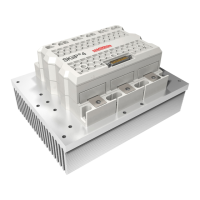© by SEMIKRON / 2017-09-07 / Technical Explanation / SKiiP
4
Page 46/73
6. Power terminals
6.1 Electrical limits
The power terminals have been designed to carry a certain rms current while providing sufficiently low
electrical loss. Hence, a feasible rms current level is specified in the corresponding datasheet. Please refer
to the corresponding section of the SKiiP module.
6.2 Mechanical constraints
6.3 Torque at terminal connections
The nuts contained in the plastic housing are utilized to ensure a proper pressure between the external
connections and the terminals of the SKiiP. The applied torque to the screws shall be sufficient ensuring
such safe connection to the terminals but should not exceed a specified torque to limit the mechanical
stress to the plastic housing preventing any damage to the plastic body. Please refer to the corresponding
information contained in the datasheet to adjust the mounting tool accordingly.
The power terminals of the SKiiP
®
4 are widely robust against external forces which may be caused by the
connection of the DC-link and load cables. Nevertheless, the SKiiP module is NOT MEANT to support the DC
link. The mechanical support must also be provided for the AC connection (e.g. inductor or motor cables) in
order to protect the power terminals from mechanical forces and vibration stress. The maximum forces that
must not be exceeded are given in Table 6—1
Table 6—1: Maximum allowable
forces to terminals
Force Maximum allowed force
F
+x
/ F
-x
300
F
+y
/ F
-y
300
F
+z
/ 200
F
-z
500

